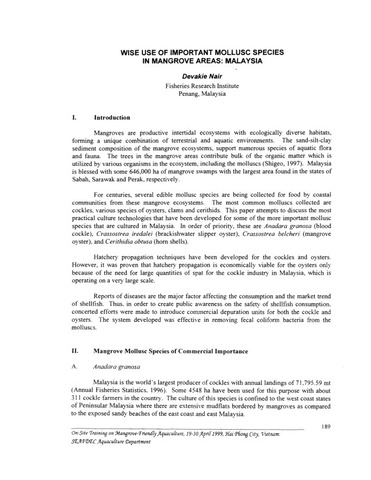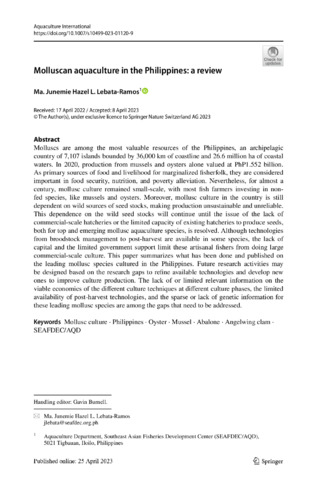Producing young, single and meaty oyster Crassostrea iredalei (Faustino, 1932) in grow‐out culture using pouches suspended from rafts
- Global styles
- MLA
- Vancouver
- Elsevier - Harvard
- APA
- Help

View/
Date
2021-06-11Author
Page views
925ASFA keyword
AGROVOC keyword
Taxonomic term
Metadata
Show full item record
Share
Abstract
Growth and survival of the slipper oyster Crassostrea iredalei using traditional (tires and oyster shells) and new methods (pouches and trays) suspended from floating rafts were compared. After six months of grow-out culture, mean shell length (mm SL) and body weight (g BW) of oysters were significantly highest in those reared in pouches (89.32 ± 0.41 mm SL, 87.70 ± 0.70 g BW), followed by those in trays (83.16 ± 0.31 mm SL, 87.06 ± 0.72 g BW), then those harvested from oyster shells (76.42 ± 0.88 mm SL, 67.35 ± 1.03 g BW), and lastly from tires (72.30 ± 1.21 mm SL, 55.07 ± 1.49 g BW). Growth rates both for length and weight were almost comparable between oysters reared in pouches (6.05 ± 1.28 mm mo−1, 10.98 ± 2.05 g mo−1) and trays (5.01 ± 1.46 mm mo−1, 10.77 ± 2.58 g mo−1). Although 60.7% of the oysters harvested from pouches (n = 1071) were classified as large (85–100 mm SL) and jumbo (100–120 mm SL) and only 39.5% of those from trays (n = 1048), their meat yield did not significantly differ (pouches = 22.60 ± 0.86%; trays = 24.76 ± 0.93%). Survival in pouches (95.2 ± 0.77%) and trays (93.15 ± 2.10%) was almost parallel at harvest. Growing oysters using the new methods produced single, larger, meatier oysters of almost the same size at a shorter culture duration.
Suggested Citation
Lebata-Ramos, M. J. H., Dionela, C. S., Novilla, S. R. M., Sibonga, R., Solis, E. F., & Mediavilla, J. P. (2021). Producing young, single and meaty oyster Crassostrea iredalei (Faustino, 1932) in grow‐out culture using pouches suspended from rafts. Aquaculture Research , 52(11), 5270-5282. https://doi.org/10.1111/are.15395
Type
ArticleISSN
1355-557X; 1365-2109Collections
- Journal Articles [1256]
Related items
Showing items related by title, author, creator and subject.
-
A method of culturing/ growing high-quality edible oysters (Crassostrea spp. and Magallana bilineata)
Lebata-Ramos, Ma. Junemie Hazel; Southeast Asian Fisheries Development Center/Aquaculture Department (Intellectual Property Office of the Philippines, 2024-11-18)This utility model discloses a process of culturing/ growing high-quality edible oysters (Crassostrea spp. and Magallana bilineata) comprising the steps: selecting grow-out culture sites, deploying substrates ... -
Wise use of important mollusc species in mangrove areas: Malaysia
Nair, Devakie (Aquaculture Department, Southeast Asian Fisheries Development Center, 2000)For centuries, several edible mollusc species are being collected for food by coastal communities from these mangrove ecosystems. The most common molluscs collected are cockles, various species of oysters, clams and ... -
Molluscan aquaculture in the Philippines: A review
Molluscs are among the most valuable resources of the Philippines, an archipelagic country of 7,107 islands bounded by 36,000 km of coastline and 26.6 million ha of coastal waters. In 2020, production from mussels and ...






